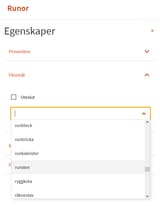Search Results
6/1/2025, 12:19:22 PM
>>24428333
>Does the book "Runic Poetry (Skaldic Poetry of the Scandinavian Middle Ages, 6)" actually exist?
On some level, it must, considering there's metadata in Anna's archive. Anyway, I'm not of much help when it comes to English language resources on the matter, as I've never used any. Runology is a Scandinavia-centric field, and the primary language used in its study is Swedish (Sweden alone has more than half of all known runic inscriptions in the world), Scandinavian languages, as well as German. It's one of those academic fields where you simply need to learn a language just to engage with it.
>there seems to be very little kino material written in Futhark
Depends on your definition, I guess. The Runic corpus is kino for its philological value alone, but the average inscriptions are indeed formulaic (memorials carved into stone). Runology is a philological field first and foremost. The Rök stone is debated to this day, and runologists are still trying to decode it; runologist Henrik Williams put forth the latest interpretation, iirc, and wrote a book on it.
The Karlevi stone is also interesting, as it starts with prose and ends in a stanza composed in dróttkvætt, which makes for the oldest attestation of it, and it's assumed the carver was a western (Norwegian) skald. I've seen this in person more than once, and it's always a nice one to stop by and admire.
>Codex Runicus is almost entirely a legal text
And very late. It is speculated it exists simply because Valdemar II of Denmark had an interest in runes. You normally wouldn't pen this kind of stuff this way.
>> e<...> in <...>R
Damaged or worn, or otherwise illegible, inscriptions. There's a few of those, especially on smaller items like bracteates. Try looking for stones for lengthier, and intact, inscriptions. If using the National Heritage Board's online version of the database, you can user Advanced Search to filter what kind of item you want to search for, material its made of, dating of the item, location, down to to minutiae (this is very helpful for observing dialectal distribution), and of course, what language/dialect (group), or language stage, you're looking for.
But perhaps I should also address the elephant in the room and say that none of this is Classical ON. The classical period started later, and Icelandic authors were hyperproductive during that time, making the total ON corpus overwhelmingly western. The runic corpus is overwhelmingly eastern, and predates the classical period.
>Does the book "Runic Poetry (Skaldic Poetry of the Scandinavian Middle Ages, 6)" actually exist?
On some level, it must, considering there's metadata in Anna's archive. Anyway, I'm not of much help when it comes to English language resources on the matter, as I've never used any. Runology is a Scandinavia-centric field, and the primary language used in its study is Swedish (Sweden alone has more than half of all known runic inscriptions in the world), Scandinavian languages, as well as German. It's one of those academic fields where you simply need to learn a language just to engage with it.
>there seems to be very little kino material written in Futhark
Depends on your definition, I guess. The Runic corpus is kino for its philological value alone, but the average inscriptions are indeed formulaic (memorials carved into stone). Runology is a philological field first and foremost. The Rök stone is debated to this day, and runologists are still trying to decode it; runologist Henrik Williams put forth the latest interpretation, iirc, and wrote a book on it.
The Karlevi stone is also interesting, as it starts with prose and ends in a stanza composed in dróttkvætt, which makes for the oldest attestation of it, and it's assumed the carver was a western (Norwegian) skald. I've seen this in person more than once, and it's always a nice one to stop by and admire.
>Codex Runicus is almost entirely a legal text
And very late. It is speculated it exists simply because Valdemar II of Denmark had an interest in runes. You normally wouldn't pen this kind of stuff this way.
>> e<...> in <...>R
Damaged or worn, or otherwise illegible, inscriptions. There's a few of those, especially on smaller items like bracteates. Try looking for stones for lengthier, and intact, inscriptions. If using the National Heritage Board's online version of the database, you can user Advanced Search to filter what kind of item you want to search for, material its made of, dating of the item, location, down to to minutiae (this is very helpful for observing dialectal distribution), and of course, what language/dialect (group), or language stage, you're looking for.
But perhaps I should also address the elephant in the room and say that none of this is Classical ON. The classical period started later, and Icelandic authors were hyperproductive during that time, making the total ON corpus overwhelmingly western. The runic corpus is overwhelmingly eastern, and predates the classical period.
Page 1
